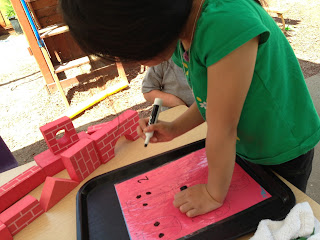In the realm of early childhood education, we are very aware of the fact that in quality preschool programs, children are "not just playing". We bring so much intentionality into everything we do and every activity we offer, taking into account children's interests, levels of development, and developmental goals for each child.
Free play is offered to children in abundance at Beansprouts Preschool. However, free play is observed and guided appropriately when children are unfocused or seem to need more grounding. A high level of awareness is necessary to assess where the children are on any particular day, and what they need from us. It is only on my very worse days as a teacher that I am just "getting through the day", meaning the activities aren't happening but they just aren't presented with the usual level of intentionality behind them. Most of the time, we plan specific activities, areas of the classroom, new works, and new games for the children with specific developmental goals in mind. Sometimes, this is intuitive. Sometimes we plan it out weeks ahead of time. Some days, the best thing for the children is to allow them to fully direct their own play. On other days, more teacher facilitation is needed. To the untrained eye, all of these approaches could look exactly the same. However, we work hard to implement a program that is "right" for each child. So while it looks like the children are "just playing", they are playing in an environment that we have set up with utmost care.
***
In this photo, K and C are using boats in a muddy river made by Sh. Just playing? No way! This is a two-year-old and a four-year-old completely engaged in give-and-take of truly cooperative play. The dialogue was rich with inquiry, as they checked in with one another to ensure they were both aligned with their self-created rules. Not to mention that they are playing in a river that Sh spent an hour digging and directing.
In the next photo, K is putting on dress-up clothes. In the safety of a costume, children get to take on other roles (which has much significance in their cognitive development), explore different parts of themselves, and interact in new and highly flexible ways with others. In pretend play, anything is possible!
If the significance of this activity seems obvious, well it is. Puzzles offer multi-level brain development. But the most important part of this activity was the teamwork involved in putting the puzzle together!
We make our own board games with our own goals in mind. For instance, in this board game, the sea creatures are trying to make it to the birthday party at the end of the game. But it takes more than one to have a party, so they wait for their friends to arrive at the birthday party before ending the game! This encourages team-playership and a sense of camaraderie.
Loose parts like these pool noodles are important in allowing us to tap into the world of the child. When they have loose parts to play with (blocks, sticks, rocks) that are completely open-ended, we get to see where their minds and hearts take them. We really get to know the children by observing their open-ended play.
Structured activities like this tracing and numeral matching work are offered as children begin to show interest and readiness in fine motor and academic learning. Because we work with a mixed age group, we don't impose a "way" to do this, but offer an option and allow them to use it in whatever way they are ready.
Sensory tables tap into parts of the brain that other activities simply cannot. The way children gravitate toward sand, water, and mud ensures us that these sensory materials fulfill something vital for them.
They aren't just playing, and we aren't just watching. There is a whole symbiotic, synergistic flow at work that allows the children to teach us exactly what we need to teach them. As one of my mentors used to say, everything we need to know is right in front of us. We just need to look to the child and listen for the answers.









